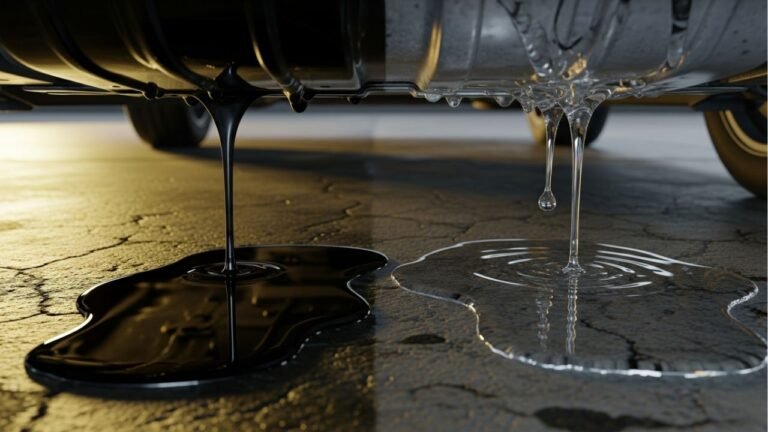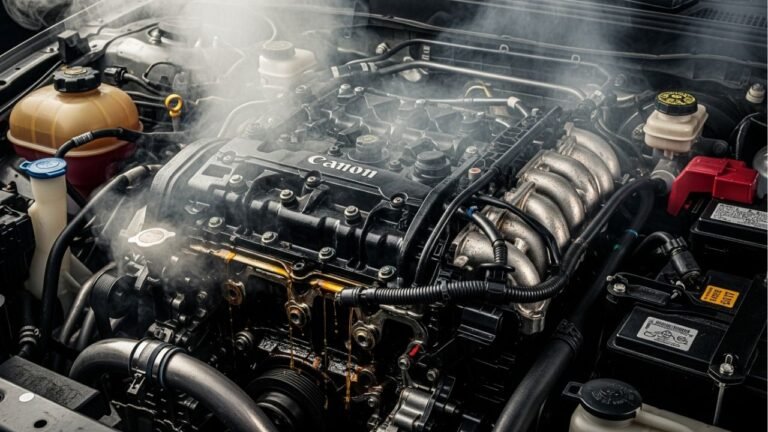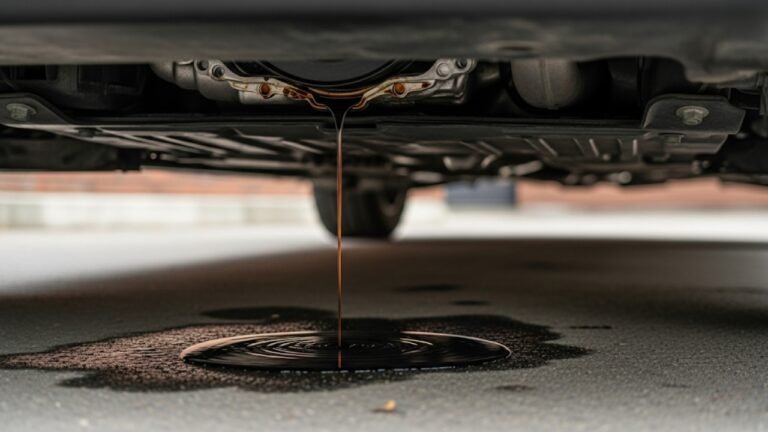Can You Drive a Car With Oil Leak?

Imagine this. You walk out to your car on a quiet morning. The air is fresh, coffee in hand, but something steals your attention. A dark puddle is slowly spreading under your engine. You bend down. Touch it. It’s oil.
Your heart sinks.
We’ve all had that “uh-oh” moment. You start wondering: can you drive a car with oil leak and still be safe? Should you call a mechanic or risk a short trip? What’s the worst that could happen?
This article isn’t just technical — it’s real. We’ll talk through experience, emotion, fact, and instinct. We’ll explore whether driving with an oil leak is dangerous, how to spot the signs early, and what your car is desperately trying to tell you.
Because sometimes, your car is crying for help — and a few drops of oil might just be its tears.
In This Article
- 1 What Happens Inside Your Engine When Oil Is Missing?
- 2 Spot the Signs: Is Your Car Leaking Oil?
- 3 The Real Answer: Can You Drive a Car With Oil Leak?
- 4 Types of Oil Leaks and Their Severity
- 5 Why People Still Drive With Oil Leaks: The Psychology Behind It
- 6 Temporary Fixes: Band-Aids for Bigger Wounds
- 7 What Happens If You Ignore an Oil Leak?
- 8 The Real Cost: Repairing an Oil Leak
- 9 How to Check Oil Levels (So You Don’t Get Caught Off Guard)
- 10 How to Prevent Oil Leaks in the Future
- 11 What to Do If You Have to Drive With a Leak
- 12 Final Thoughts: What Your Car Is Trying to Tell You
What Happens Inside Your Engine When Oil Is Missing?

Now, picture your engine running low on oil. Friction builds. Heat rises. The metal parts begin to grind against each other like bone on bone. Without lubrication, the engine starts tearing itself apart from the inside.
That’s not an exaggeration. Oil starvation can cause irreversible engine damage.
And if the leak is slow, you might not even know it until it’s too late. So if you’re still wondering can you drive a car with oil leak, think of it like jogging with a bleeding wound. You can, sure. But should you?
That’s where awareness comes in. Recognize the signs. Know the risks. Because when oil runs dry, time runs out fast.
Spot the Signs: Is Your Car Leaking Oil?
Before asking can you drive a car with oil leak, ask yourself: is your car really leaking oil? Here’s how to tell.
Signs of an oil leak:
-
Dark puddles under the car after parking overnight.
-
Burning oil smell inside the cabin.
-
Blue smoke from the tailpipe.
-
Oil warning light on the dashboard.
-
Sticky grime around the engine gasket area.
If you catch even one of these signs, take it seriously. A minor leak can grow into a full-on hemorrhage if left unchecked.
Quick visual inspection:
| Checkpoint | What to Look For |
|---|---|
| Under the car | Black/brown puddles |
| Around oil pan gasket | Wetness or sludge buildup |
| Engine bay (dipstick) | Rapidly dropping oil level |
| Tailpipe emissions | Blue or bluish-gray smoke |
Oil leaks rarely fix themselves. And while it’s tempting to ignore that tiny drip, remember: it’s only “small” until your engine gives up.
The Real Answer: Can You Drive a Car With Oil Leak?
Here’s the truth. Yes, you can drive a car with an oil leak — for a while. But you really shouldn’t.
Let’s be honest — life gets busy. You’ve got work, errands, maybe even a road trip. And when the leak seems minor, you tell yourself, “It’ll be fine. Just one more drive.”
But every time you run the engine, you’re gambling. Oil levels drop. Heat increases. And your engine silently suffers.
I once made this mistake. It started with a few drops on my driveway. I ignored it. Two weeks later, stuck in traffic, my engine seized. That moment cost me thousands. And I still regret not acting sooner.
Driving with an oil leak is like walking a tightrope with frayed rope. You might make it across. But every mile increases the odds that you won’t.
So while the answer is “yes,” the real answer — the wise answer — is “don’t.”
Types of Oil Leaks and Their Severity
Not all leaks are created equal. Some are slow drips. Others are catastrophic blowouts. Here’s a quick breakdown of the most common types of oil leaks and what they mean for your drive.
Common Oil Leak Sources:
-
Valve Cover Gasket
Small, slow leaks. Manageable at first but gets worse over time. -
Oil Pan Gasket
Moderate leak. Often leads to visible puddles and needs attention quickly. -
Rear Main Seal
Serious leak. Often requires engine removal for repair. -
Oil Filter or Drain Plug
Can be simple if caught early. Dangerous if loose or cross-threaded. -
Oil Cooler Line
Can result in fast oil loss and severe engine damage.
Severity Table:
| Leak Source | Severity | Safe to Drive? |
|---|---|---|
| Valve Cover | Low–Moderate | Short trips only |
| Oil Pan Gasket | Moderate | Risky |
| Rear Main Seal | High | Avoid driving |
| Oil Filter/Drain Plug | High | Only to repair shop |
| Cooler Line | Very High | Dangerous |
Even a small leak can become a big one in seconds. A pothole, speed bump, or pressure spike can suddenly turn a manageable drip into a total oil loss.
So again — the question can you drive a car with oil leak isn’t just about distance. It’s about risk.
Why People Still Drive With Oil Leaks: The Psychology Behind It
Let’s get honest. Most people don’t ignore oil leaks because they don’t care. They ignore them because they’re overwhelmed.
Repairs are expensive. Time is limited. Maybe you’re between paychecks, or your schedule is packed. So you delay. You hope the problem stays small. It’s human.
We’ve all done it.
But cars aren’t like people. They don’t heal. A leaking car doesn’t get better on its own — only worse.
When I was in college, I drove a beat-up Honda that leaked oil like a sieve. I kept a gallon of oil in the trunk and topped it off every two days. I told myself I was saving money. In reality, I was one trip away from a disaster.
Don’t wait for that disaster. If money’s tight, at least monitor your oil level daily. Park over cardboard. Use stop-leak oil temporarily if needed. But plan the repair.
The cost of ignoring a leak is always higher than the cost of fixing it.
Temporary Fixes: Band-Aids for Bigger Wounds
If you’re caught in a situation where you must drive — say, to a mechanic — there are a few short-term measures to reduce risk.
Temporary actions:
-
Top off the oil every few miles or daily.
-
Use a stop-leak additive (very temporary and not a cure).
-
Avoid high-speed or long drives.
-
Monitor oil pressure and warning lights constantly.
-
Keep extra oil in your trunk.
But let’s be crystal clear: these are not solutions. They’re survival tactics. And they should only be used as an emergency measure to get you to safety — not as an excuse to delay proper repairs.
Think of it like taping a cracked pipe in your home. It might hold for a bit, but water’s still going to find a way out.
What Happens If You Ignore an Oil Leak?
Ignoring an oil leak is like letting termites live in your walls. You don’t see the damage at first. But one day, the whole thing collapses. The same goes for your engine.
When oil keeps leaking and isn’t replaced fast enough, several things can go wrong:
-
Friction increases – metal parts grind, wear, and overheat.
-
Engine temperature rises – risking overheating and cracked gaskets.
-
Fuel efficiency drops – the engine works harder with less lubrication.
-
Sludge forms – oil turns thick, dirty, and useless.
Eventually, the engine can seize. That means it locks up, freezes, and dies. And when that happens, it’s often cheaper to buy another car than fix the one you’ve got.
I’ve known people who spent $3,000–$5,000 on engine replacements because they ignored an oil leak that would’ve cost $150 to fix early. Don’t let that be your story.
Driving with an oil leak isn’t just risky. It’s slow-motion suicide for your engine.
The Real Cost: Repairing an Oil Leak
Let’s talk about the money. That’s the part nobody loves, but everybody needs to know.
Here’s a breakdown of common oil leak repair costs:
| Component | Repair Cost (Approx.) |
|---|---|
| Valve Cover Gasket | $100–$400 |
| Oil Pan Gasket | $200–$600 |
| Rear Main Seal | $500–$1,500+ |
| Oil Filter Housing | $150–$450 |
| Timing Cover Gasket | $300–$1,200 |
Prices vary by location and vehicle model. Luxury or imported cars can be double the cost. Labor makes up a big chunk, especially if the mechanic has to remove the transmission or other major parts.
But here’s the truth: it always costs less to fix early. A $300 repair today can save you $3,000 tomorrow.
And many independent shops offer flexible payment options. You don’t always have to fix everything at once. Just don’t ignore it entirely.
How to Check Oil Levels (So You Don’t Get Caught Off Guard)
The easiest way to protect your engine if you’re unsure about a leak? Check your oil regularly. It takes 2 minutes. No tools. No hassle. Just habit.
Here’s how to do it:
-
Park on level ground and let the engine cool for 10 minutes.
-
Pop the hood and find the dipstick (yellow or orange handle).
-
Pull it out, wipe it clean with a rag or paper towel.
-
Reinsert it fully, then pull it back out.
-
Check the oil level against the “low” and “full” marks.
-
If it’s low, top it off using the correct oil grade.
Make this part of your weekly routine — especially if you suspect a leak. That one habit alone could save your engine.
When people ask me now, “can you drive a car with oil leak?”, I say, “Only if you’re watching that dipstick like a hawk.”
How to Prevent Oil Leaks in the Future
Once you’ve had an oil leak, trust me — you’ll do anything to avoid another. Good news is, most leaks are preventable with basic care.
Tips to prevent oil leaks:
-
Change oil on time – Old oil breaks down and causes gasket failure.
-
Use the right oil – Thinner or thicker oil than recommended can mess with seals.
-
Avoid over-tightening bolts – Especially the drain plug.
-
Replace gaskets and seals as preventive maintenance after 100K miles.
-
Get regular engine inspections during oil changes.
-
Watch for small leaks and act fast — tiny issues become huge fast.
Think of your engine like your health. Catching something early always leads to better outcomes.
What to Do If You Have to Drive With a Leak
Sometimes, life throws curveballs. You’re on a road trip, or in the middle of nowhere. Your car starts leaking, and there’s no shop nearby. What then?
Here’s a survival plan:
-
Pull over immediately. Check for oil dripping fast.
-
Top off oil if you have it in your trunk.
-
Use a temporary stop-leak additive to slow the drip.
-
Drive only to the nearest service location — slowly.
-
Avoid hard acceleration, high RPMs, and long idle times.
This is not a long-term plan. It’s an emergency route. If you make it to safety — don’t push your luck again. Book a proper repair as soon as you can.
Driving with an oil leak is like driving with a ticking clock. You don’t know when the time will run out — only that it eventually will.
Final Thoughts: What Your Car Is Trying to Tell You
Let’s bring it back to the big picture. Can you drive a car with oil leak? Technically, yes. Practically, no. Morally — not if you care about your car.
Every drop of oil on your driveway is a message. A whisper. A cry. Your car is asking for help.
Ignoring it might feel easy in the moment. But every mile you drive with an oil leak is borrowed time. You’re stacking risk, trip by trip, until one day — it ends in a breakdown.
And breakdowns don’t come with warning bells. They come with tow trucks.
So listen to your car. Check the oil. Watch the dashboard. Look for puddles. Fix leaks early. Because when you take care of your car, it takes care of you — every mile, every memory, every road trip, every ordinary day that turns into something unforgettable.
And trust me — nothing ruins a memory faster than being stuck on the side of the road with a blown engine.






